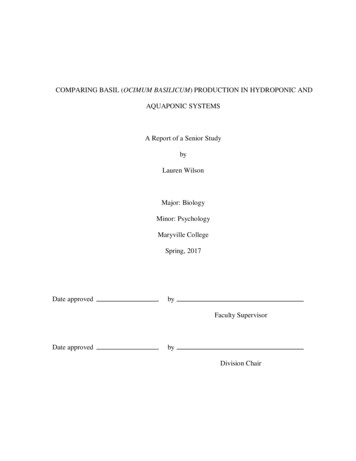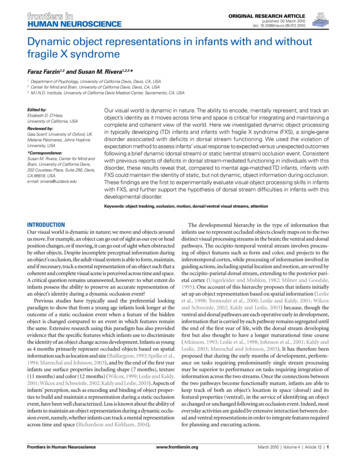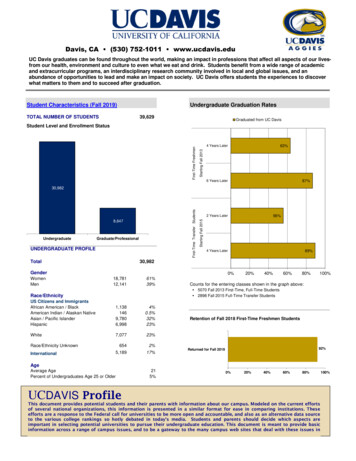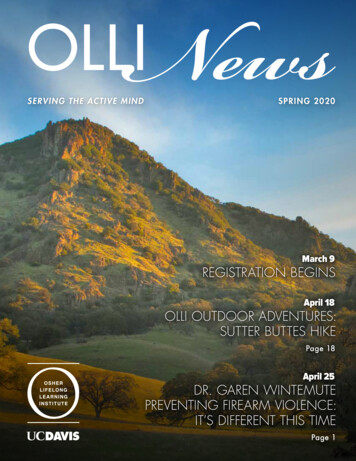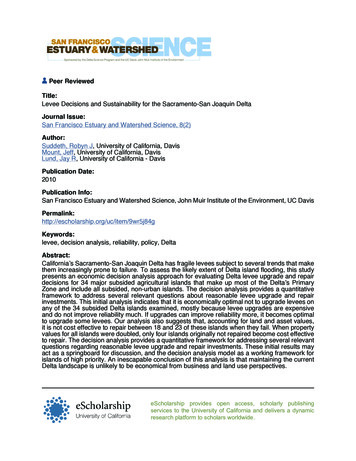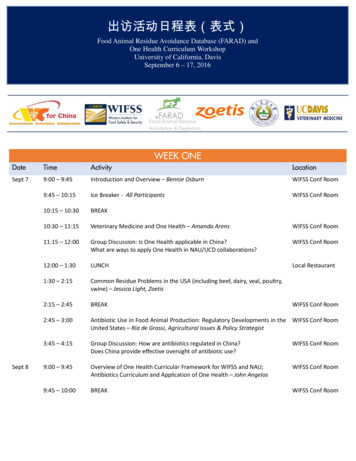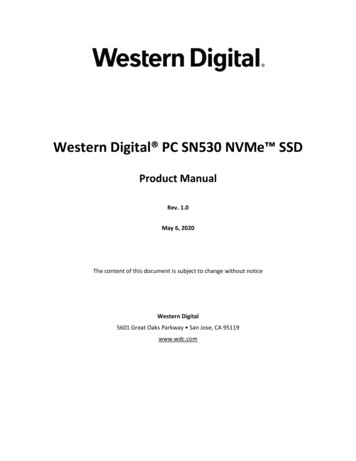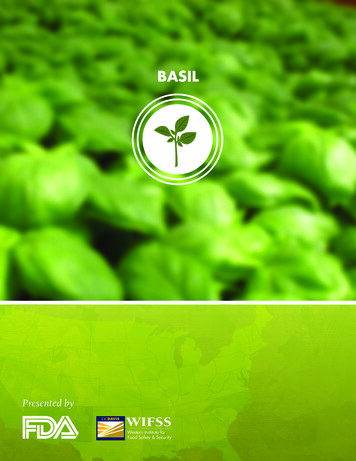
Transcription
BASILPresented by
BASILThis production summary provides an overview of basil growing, harvesting, and post harvesting practices. There aresome common practices that many large commercial growers use when producing basil, and though there are variationsin these practices, having an understanding of the most common methods used will be helpful when carrying outregulatory activities.By the end of this summary, you will be able to:1. Describe the differences between the varieties of commercially produced basil.2. List the top basil producing regions.3. Identify the most common farming practices used in the production of basil.INTRODUCTIONBasil is a member of the mint family. Sweetbasil is the most common culinary basil.Physically, basils are characterized bysquare, branching stems, opposite leaves,brown or black seeds, and flower spikes.Large-leaved basils, such as sweet basil, Italian basil, andlettuce-leaf basil can grow two to three feet in height. Smallleaved basil such as lemon basil, dwarf basil, bush basil,or spicy globe basil will grow 8 to 12 inches in height andwidth. Reddish-purple variations such as Dark Opal andPurple Ruffles tend to be intermediate in size, bearing purpleinstead of white flowers. Although these varieties have minornuances in flavor, they are used for food preparation.In the United States, basil is grown commercially in westernand southern states where the climate is favorable includingArizona, California, Florida, New Mexico, and North Carolina(Fig 1). Production statistics for basil are not trackedindividually, but they are included in the larger ‘herb’ category.Mexico is a larger exporter of basil to the United States.Basil is cultivated in climates withtemperatures ranging from 45 toGROWING80 F. This tender herbaceous annual issusceptible to frost and cold-temperatureinjury. It develops best during long days inthe full sun with well-drained soil.Basil can be directly seeded or transplanted to the field inlate spring once all danger of frost has passed.Fig 1 - Top Basil Producing States in the USRows are planted 25 to 35 inches apart, with plants spacedevery six inches. Basil can also be planted in raised bedsin rows of three lines. The distance between rows isBASIL 2
Basil does not tolerate water stress and needs to be wateredregularly. Drip irrigation is preferred since it minimizesdamage to foliage caused by moisture contact with the leaves.The need for fertilizing basil is determined by soil type,previous applications of fertilizer, and previous crop type. Ingeneral, a fertilizer that provides nitrogen, phosphorus, andpotassium is recommended. Fertilizer can be spread over afield and plowed in or applied by ‘side dressing,’ whichrefers to application of a fertilizer between the rows of agrowing crop.Alice Henneman via flickr.comdetermined by a grower’s equipment, but generally rangesfrom 10 to 15 inches.Soil is kept moist to encourage germination and improveplant establishment. Germination occurs within eight to 14days after seed planting. Initial growth is slow, but after thefirst few sets of leaves appear, growth increases dramatically.Some small growers use transplants to raise basil as anannual crop for the fresh basil market. Transplants normallyrequire approximately 28 to 42 days for growth. Lateralbranching and growth may be encouraged by topping whenthe plants are five inches high. Topping promotes branchingand helps to maximize plant growth when three to five setsof true leaves are present. True leaves appear as the secondset of leaves after a plant germinates. (The first set of leavesare the plant’s food structure and are not leaves at all.)Basil is typically grown commercially without theapplication of herbicides after plant emergence. Growersrely on mechanical cultivation, high plant populations, useof mulch, and manual weed removal for weed control.Although a variety of different insect, fungal, viral, andnematode pests can affect basil, relatively few pesticides areapproved for use on growing basil plants. Novel or organicmethods such as biological control using beneficial insectsor bacteria, insecticidal soaps, plant extracts, pest traps,manual pest removal, and organic insecticides are used. Insome cases, applications of chemical controls can be appliedduring pre-planting or pre-emergence.The part of the plant that is harvestedandthe timing of the harvest depend onHARVESTINGthe anticipated use of the herb. For driedbasil leaves, the plant is cut just prior toappearance of flowers. To produce essentialbasil oil, the plant is harvested when the flowers are infull bloom.In warmer climates, three to five cuttings can be madeper year. In cooler climates, the growing season may onlyallow two cuttings per year; the first usually begins in earlysummer and the second just before bloom.Basil leaves are harvested above the bottom two to foursets of true leaves for fresh and dried markets. In largercommercial operations, basil plants are cut four to fiveinches above the ground to allow for regrowth. Plantingand harvesting dates are staggered to allow continuity in thesupply of fresh basil leaves.Charlie Vinz via flickr.comFor the fresh market, the length of the stem may beimportant, as is the pack or bundle size and weight. Smallscale production is labor intensive and requires that workerscut leaves using a sharp sickle type knife and place the looseleaves in a tote or container.BASIL 3
For large scale commercial operations, harvesting isconducted by using a modified sickle bar/jerry mower pulledby a tractor. The height of the cutting blade is adjustabledepending the cut required. Some growers harvest the entireplant depending on market demand.PACKINGIf marketed fresh, the leaves are washedand cleaned, removing all weeds andextraneous field material.Basil is packaged in bulk boxes in thefield and transferred to storage rooms below 50 F for shortperiods of time without inducing chill damage. Shipped to apackinghouse, the herb is hand sorted and placed into smallplastic clam shells for retail sales. Whole plants are wrappedin plastic to maintain their integrity.HOLDINGNorbert Schnitzler via CCPostharvest handling greatly impactsaroma, flavor retention, and leaf color.When dried, the leaves are usually notsubjected to temperatures over 90 F.For the dried herb, low temperature drying of the leavesunder forced air is used to retain maximum color prior tomilling or distillation to extract essential basil oil.CONCLUSIONHaving a basic understanding of the way basil is grown, harvested, and cooled will provide thebasic background information that will be helpful to regulators when completing inspections orinvestigations in the field.The agricultural practices described in this production summary are common on most large commercial farmslike those found in major basil producing regions in the United States. There are undoubtedly variations inthese practices depending on the region, operation size, and individual grower preferences. This is especiallytrue of farms outside of the U.S.BASIL 4
REFERENCES“Basil Production.” Essential Oil Crops. Department of Agriculture, Forestry, & Fisheries, Republic of South Africa, 2012. Web. 22June 2015.Diver, Steve. “Greenhouse and Hydroponic Vegetable Production Resources on the Internet.” National Center for AppropriateTechnology, 2004. Web. 22 June 2015.Holmstrom, Kristian E., Gerald M. Ghidiu, Christian A. Wyenandt, and Bradley A. Majek. “Crop Profile for Basil in New Jersey.”Rutgers Agricultural Research and Extension Center, 2008. Web. 23 June 2015.Meyers, Michele. “Basil.” Herb Society of America Guide. The Herb Society of America, 2003. Web. 22 June 2015.Mossler, Mark A. “Florida Crop/Pest Management Profile: Herbs (Basil, Cilantro, Dill, Mint, Parsley, Rosemary, Sage, Thyme.”Pesticide Information Office, Agronomy Department, University of Florida Extension, Mar. 2014. Web. 22 June 2015.Savio, Yvonne and Curt Robinson. “Basil.” Rain.org. University Extension, UC Davis, 21 July 1992. Web. 23 June 2015.Simon, James E. “Basil.” Crop Fact Sheet. Purdue University, 1995. Web. 22 June 2015.Simon, James E. “Sweet Basil: A Production Guide.” Purdue University, Cooperative Extension Service, Jan. 1985. Web. 23 June2015.Succop, C. Elizabeth. “Hydroponic Greenhouse Production of Fresh Market Basil.” Department of Horticulture and LandscapeArchitecture, Colorado State University, 1998. Web. 22 June 2015.USDA. “Hawaii Vegetable and Herb Report.” National Agricultural Statistics Service, 12 Nov. 2013. Web. 23 June 2015.Funding for this presentation was made possible, in part, by the Food and Drug Administration through Cooperative Agreement 1U54FD004327. Views expressed in thispresentation do not necessarily reflect the official policies of the Department of Health and Human Services; nor does any mention of trade names, commercial practices, ororganization imply endorsement by the United States Government.BASIL 5
A PDF about the growing, harvesting, and post-harvesting practices of the basil commodity. Created Date: 8/10/2016 11:55:38 AM .
